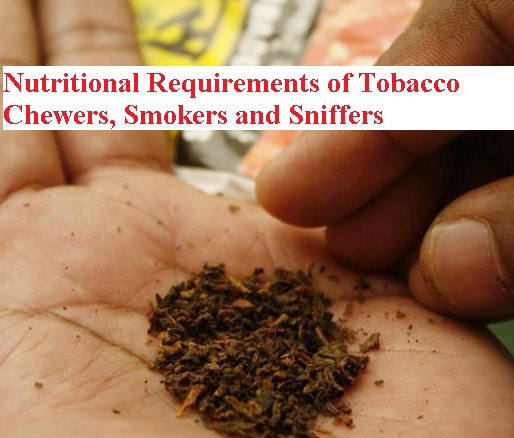Lifestyle, Sports Nutriton
Antioxidants – A Must for Tobacco Consumers
As most of you all know, alcohol, drugs like heroin, cocaine etc., and tobacco are one of the main culprits for the increased number of deaths at young age.
They all are addictive and for commercial purposes people make them still more appealing to your senses. There may be different reasons as to why someone is consuming them, but going for them frequently is like taking poison and inviting ill health with a smile on your face. Smoking tobacco and the way tobacco affects one’s health is irreversible.
So now, I would like to concentrate more on tobacco and that too smokeless tobacco initially.
[fusion_builder_container hundred_percent=”yes” overflow=”visible”][fusion_builder_row][fusion_builder_column type=”1_1″ background_position=”left top” background_color=”” border_size=”” border_color=”” border_style=”solid” spacing=”yes” background_image=”” background_repeat=”no-repeat” padding=”” margin_top=”0px” margin_bottom=”0px” class=”” id=”” animation_type=”” animation_speed=”0.3″ animation_direction=”left” hide_on_mobile=”no” center_content=”no” min_height=”none”]
What is Smokeless Tobacco?
The term “smokeless tobacco” is used to describe tobacco that is consumed in the unburnt form, either orally or nasally. And they are gaining popularity because, health risks of smoking and dangers of tobacco are becoming a major concern in today’s generation.
It is a growing socioeconomic and health concern in many countries. Though no country is an exception for this, particularly it is prevalent in underdeveloped, developing countries and even developed countries to some extent, as chewing tobacco substitute in these countries is very much common, and also the layman is unaware of the dangers of chewing tobacco.
According to WHO, the smokeless tobacco consumers ranged for 1% in some regions of America to 33% in parts of south East Asia among males. The range is between 2%-10% in case of female.
To be specific, say in some countries, such as India, the current use of smokeless tobacco among adult males is as high as 36.5% and 8.4% for females.
In Myanmar, Nepal and Sudan, the use of smokeless tobacco among males is around 25%, but prevalence figures for females differ from as low as 1% in Sudan to 11.7% in Nepal.
The highest smokeless tobacco prevalence rate was observed in Yemen with 53.1% of male consumers.
In Bangladesh the prevalence of smokeless tobacco use among females (27.9%) exceeds that of males (26.4%).
Don’t you think these figures are alarming?
Just as the figures their causal diseases are also quite outrageous and alarming.
Long Term Effects of Tobacco Consumption
They have many short term effects like gingivitis, soreness in the throat, ulcers, tooth decay and many more.
The smokeless tobacco contains about 10-15 carcinogenic substances and in the long term may lead to diseases like
- Leukoplakia (a disease of the mouth characterized by white patches and oral lesions on the cheeks, gums and/or tongue)
- Cancer of the mouth, oesophagus, pharynx, larynx, stomach and pancreas, etc.
- Bone and tooth loss.
- Cardiovascular diseases.
- They are also prone to many other diseases.
As this is a cause of concern and course quitting tobacco is the best suggestion due to so many negative effects of tobacco, still researchers are studying about how they can delay the causal diseases.
Nutritional Requirements of Tobacco Chewers, Smokers and Sniffers
Tobacco consumers do have almost same nutritional requirements as any other individual, but they may require an additional dose of direct natural antioxidants or antioxidant supplements than normal individuals.
This is because some components in tobacco generate numerous free radicals (Cigarette smoke has been estimated to contain 1,000,000,000,000,000 free radicals per inhalation.) which in turn may lead to oxidative stress and thereby cell damage in various organs.
This becomes a cause for many diseases. Free radicals can also oxidize the fat components of the body that is not desirable.
But first of all, What are antioxidants and how are they related to the diseases and how do they lower the dangers of tobacco use??
What are Antioxidants?
Antioxidants by name can be known as those potent nutrients that help to fight oxidation.
Free radicals are with a hunger for electrons, if this hunger is not satisfied; they do attack our cells and cause cell and tissue damage.
Antioxidants satisfy free radicals, subsides oxidative stress and thereby prevents cell damage.
Antioxidant nutrients seem to have protective roles about cancer, heart disease, cataract cognitive (mind) dysfunction, and perhaps some other diseases.
There seems to be a need for a balance between antioxidant protectors and components that promote oxidation in the body.
Hence, these are very essential in case of tobacco consumers where the free radicals and oxidation are triggered by the tobacco they smoke or chew.
What are the Sources for Antioxidants?
Foods containing Vitamin C, E, beta carotene, flavonoids, etc. exhibit good antioxidant property.
Know more about antioxidants, their benefits and sources.
Daily Required Intake of Antioxidants for tobacco Consumers
Consume 40 mg vitamin C daily.
Eat about nine servings of fruits and vegetables daily [/fusion_builder_column][fusion_builder_column type=”1_1″ background_position=”left top” background_color=”” border_size=”” border_color=”” border_style=”solid” spacing=”yes” background_image=”” background_repeat=”no-repeat” padding=”” margin_top=”0px” margin_bottom=”0px” class=”” id=”” animation_type=”” animation_speed=”0.3″ animation_direction=”left” hide_on_mobile=”no” center_content=”no” min_height=”none”][or, as stated otherwise, eat a diet high in antioxidant nutrients.
Research Findings
A study published in oxford journals was conducted on the rats to evaluate the effect of smokeless tobacco consumed on the antioxidant defense status and pathological changes caused in the liver, lung, and kidney.
They concluded a decrease in the antioxidant defense system and long-term inflammation, caused by smokeless tobacco, might be the risk factors for Gurkha-induced pathogenesis.
A research published on PubMed conducted a study on Protective effects of antioxidants against smokeless tobacco-induced oxidative- stress and found that there is an improvement in the protection when the subjects are treated with vitamin C,E, grape seed extract and also with a combination of Vitamin E and C.
References
Driskell, Judy A., “NF93-156 Nutrition for Tobacco Smokers & Chewers” (1993). Historical Materials from the University of Nebraska Lincoln Extension.Paper 447
Critchley JA, Unal B. Health effects associated with smokeless tobacco: a systematic review. Thorax 2003; 58(5):435-43.
Bagchi M, Kuszynski CA, Balmoori J, Joshi SS, Stohs SJ, Bagchi D.,”Protective effects of antioxidants against smokeless tobacco-induced oxidative stress and modulation of Bcl-2 and p53 genes in human oral keratinocytes” Creighton University School of Pharmacy and Allied Health Professions, Omaha, NE, USA. 2001 Aug;35(2):181-94.[/fusion_builder_column][/fusion_builder_row][/fusion_builder_container]


